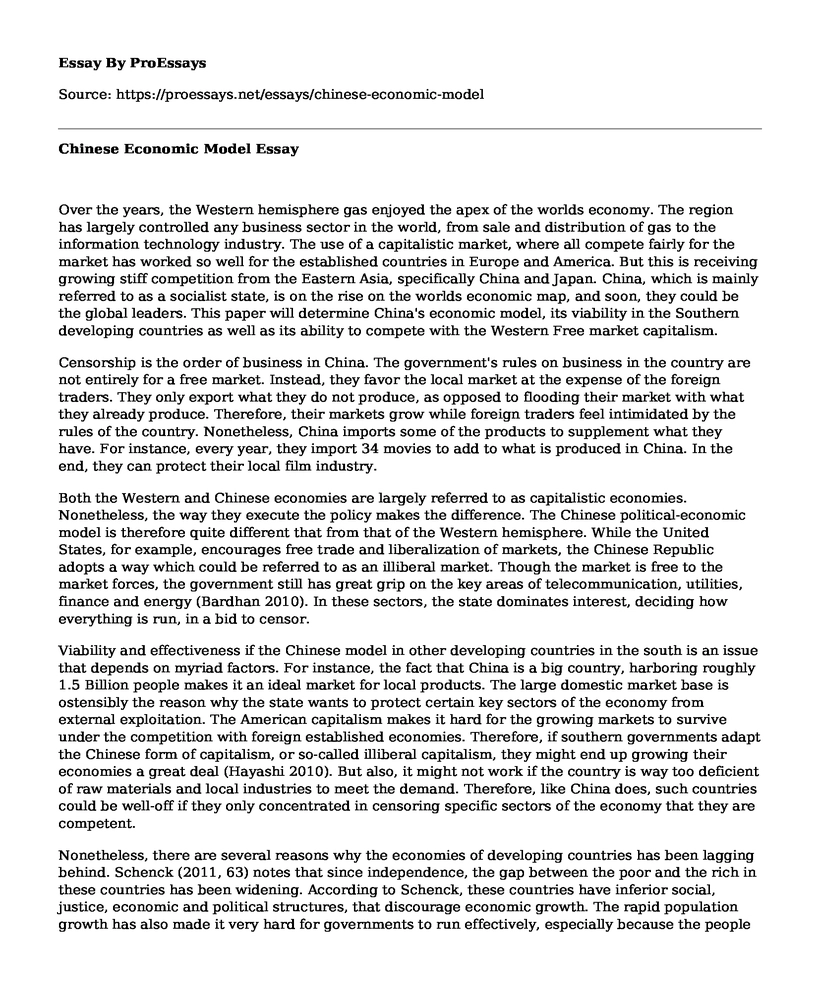Over the years, the Western hemisphere gas enjoyed the apex of the worlds economy. The region has largely controlled any business sector in the world, from sale and distribution of gas to the information technology industry. The use of a capitalistic market, where all compete fairly for the market has worked so well for the established countries in Europe and America. But this is receiving growing stiff competition from the Eastern Asia, specifically China and Japan. China, which is mainly referred to as a socialist state, is on the rise on the worlds economic map, and soon, they could be the global leaders. This paper will determine China's economic model, its viability in the Southern developing countries as well as its ability to compete with the Western Free market capitalism.
Censorship is the order of business in China. The government's rules on business in the country are not entirely for a free market. Instead, they favor the local market at the expense of the foreign traders. They only export what they do not produce, as opposed to flooding their market with what they already produce. Therefore, their markets grow while foreign traders feel intimidated by the rules of the country. Nonetheless, China imports some of the products to supplement what they have. For instance, every year, they import 34 movies to add to what is produced in China. In the end, they can protect their local film industry.
Both the Western and Chinese economies are largely referred to as capitalistic economies. Nonetheless, the way they execute the policy makes the difference. The Chinese political-economic model is therefore quite different that from that of the Western hemisphere. While the United States, for example, encourages free trade and liberalization of markets, the Chinese Republic adopts a way which could be referred to as an illiberal market. Though the market is free to the market forces, the government still has great grip on the key areas of telecommunication, utilities, finance and energy (Bardhan 2010). In these sectors, the state dominates interest, deciding how everything is run, in a bid to censor.
Viability and effectiveness if the Chinese model in other developing countries in the south is an issue that depends on myriad factors. For instance, the fact that China is a big country, harboring roughly 1.5 Billion people makes it an ideal market for local products. The large domestic market base is ostensibly the reason why the state wants to protect certain key sectors of the economy from external exploitation. The American capitalism makes it hard for the growing markets to survive under the competition with foreign established economies. Therefore, if southern governments adapt the Chinese form of capitalism, or so-called illiberal capitalism, they might end up growing their economies a great deal (Hayashi 2010). But also, it might not work if the country is way too deficient of raw materials and local industries to meet the demand. Therefore, like China does, such countries could be well-off if they only concentrated in censoring specific sectors of the economy that they are competent.
Nonetheless, there are several reasons why the economies of developing countries has been lagging behind. Schenck (2011, 63) notes that since independence, the gap between the poor and the rich in these countries has been widening. According to Schenck, these countries have inferior social, justice, economic and political structures, that discourage economic growth. The rapid population growth has also made it very hard for governments to run effectively, especially because the people have caused serious stress on resources. Also, because these countries are over reliant on the export of single commodities, they are subject to serious global market changes and fluctuations. Therefore, these economies need to open up their market to other traders while at the same time taking enough caution in regard to their own local produce (Schenk 2011).
Soon, the western economy systems could be challenged by the Chinese illiberalism. At least, this has been proved by how increasingly the rate of expansion of the Chinese economy has been over the last decade. Free market capitalism, in this case, might end up losing popularity among most southern countries. Especially the fact that the Chinese method seems workable for growing markets makes it appealing to all the developing economies. Though many critics argue that the Chinese market system has encouraged a good unemployed economy,' the Forbes Magazine confirms there are more dollar billionaires in Shanghai than there was a decade ago.
List of References
BIBLIOGRAPHY
Schenk, Catherine R. 2011. "International Economic Relations Since 1945." Routledge 64.
Bardhan, Pranab. 2010. "The Paradigm Of Capitalism Under A Developmental State: Does It Fit China And India?" Singapore Economic Review No. 2 ( 55): 243-251.
Hayashi, Shigeko. 2010. "The Developmental State In The Era Of Globalization: Beyond The Northeast Asian Model Of Political Economy." Pacific Review 23, No. 1: 45-69." Pacific Review No. 1 (23): 45-69.
Cite this page
Chinese Economic Model. (2021, May 17). Retrieved from https://proessays.net/essays/chinese-economic-model
If you are the original author of this essay and no longer wish to have it published on the ProEssays website, please click below to request its removal:
- Course Work Example: Reasons That Drove to the Transformation of G7 into G20
- Global Food and Feed Production Business Intelligence Dashboards Paper Example
- Key Drivers of Oil Price Changes in the Past Paper Example
- Essay Sample on Optimism in the United States
- Essay Sample on Unchecked Globalization: Trade Security at Risk?
- Essay Example: Winning the War on Urban Terrorism in the US
- The Eighteenth Century Slavery - Essay Sample







